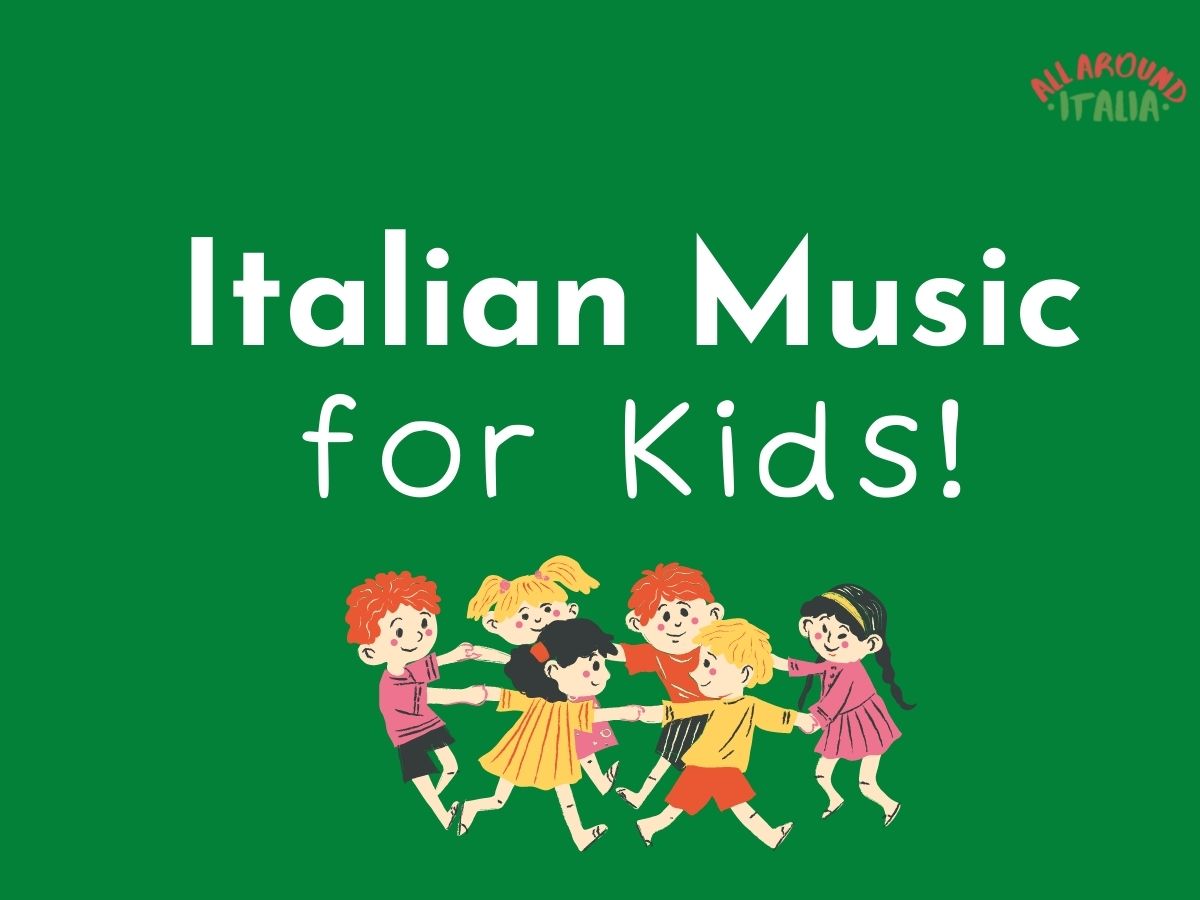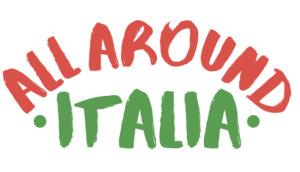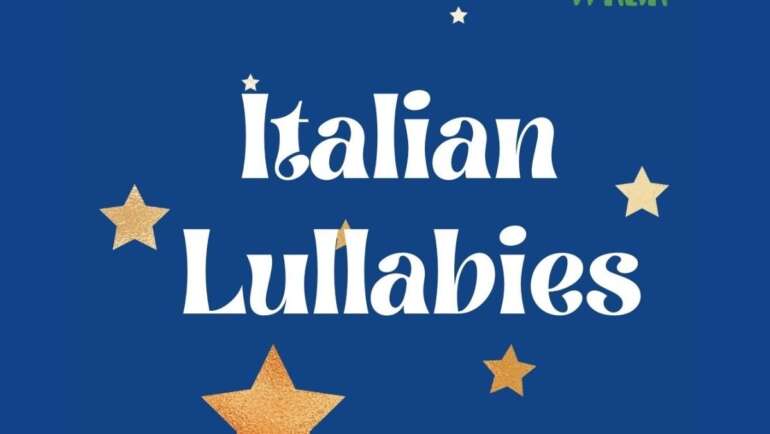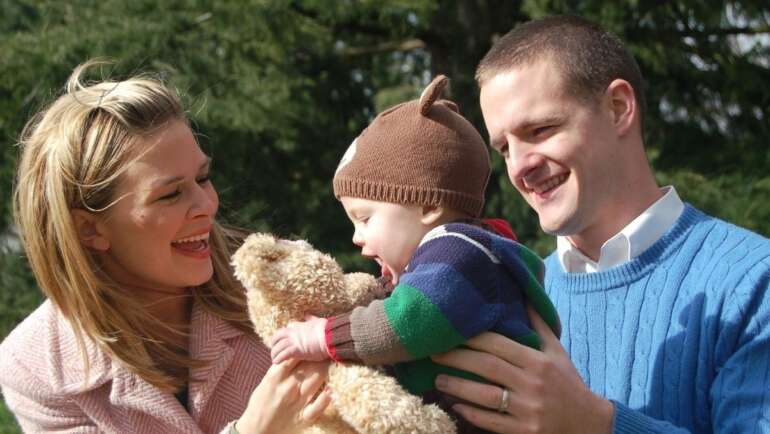Learn our favorite Italian songs for kids, and share language through music.
My family loves Italian children’s songs! Music is a wonderful way to learn a language, and there are so many fun Italian songs for kids. In this post, we share our favorites. These songs are perfect for singing and dancing together. If you’re looking for lullabies, you won’t find many options in this post (but you will here!).
All the songs featured are uniquely Italian. They don’t have English versions that you already know. To make it easy for you to follow along and learn the words, every song is linked to a Youtube video with lyrics or closed captions. You can also find all these songs – and many more! – on the All Around Italia Spotify playlists.
Table of Contents

Papaveri e papere seems to be one of those songs that every Italian knows. When my husband held our newborn daughter, he began singing “e tu sei piccolina, e tu sei piccolina”. And that’s how I discovered the song!
This lively tune is about a duck and a poppy flower who show an interest in each other and then get married. Soon after, the poppy blows away in the wind. Upon doing research, I learned this is symbolism: things don’t work out when a commoner (little duck) mixes with a powerful politician (tall poppy). When we sing with my daughter though, it’s really just about a duck and a poppy.
Papaveri e papere was composed by Mario Panzeri, Nino Rastelli, and Vittorio Mascheroni. It was originally sung by Nilla Pizzi, the artist who won Italy’s first Festival of San Remo in 1951.
If you want to put your Italian pronunciation to the test, sing this song! It is fast-paced and full of clever variations of words with a root of “pap”. The bouncy and measured rhythm make Papaveri e papere the perfect song for marching around with your little one (my daughter loved doing this!).
Chorus:
Lo sai che i papaveri son alti, alti, alti,
e tu sei piccolina, e tu sei piccolina.
Lo sai che i papaveri son alti, alti, alti,
sei nata paperina, che cosa ci vuoi far …
A traditional Italian kids’ song, La zia di Forlì is about an auntie from Forlì (a town in Emilia-Romagna) who goes dancing! The auntie moves her feet … her knees … then her arms … then her head. She moves them in a specific way, “così, così”. With every addition of a body part, the music speeds up. It ultimately becomes a crazy fast dance!
When singing La zia di Forlì with your kids, add more body parts to the sequence. It’s a great way to teach your child the names of body parts in Italian.
In particular for younger kids, La zia di Forlì is bound to be a hit. I was introduced to this song during my time assistant teaching Italian at a public school in Boston. The first time I walked into the pre-K class with the teacher, one child stood up, started pumping his arms and chanting “così, così”. In no time, the whole class was demanding we sing the song … hilarious. Clearly, it’s a winner with the little ones!
Chorus:
Io ho una zia, una zia che sta a Forlì
E quando va a ballare con “il piede” fa così
Così, così, con “il piede” fa così
Così, così, con “il piede” fa così
Il coccodrillo come fa? What sound does a crocodile make? In this silly song by Oscar Avogadro and Pino Massara, the bambina singing is very perplexed by this question. She knows dogs bark, cats meow, cows moo, etc … but what does a crocodile do? No one seems to have the answer!
As the chorus goes – the crocodile eats too much, never wears his winter jacket, bites with his teeth, cries often, gets mad but doesn’t yell, drinks chamomile, and walks around half-asleep. A very busy (and interesting!) creature. But it remains a mystery what sound he makes!
A popular children’s song in Italy, Il coccodrillo come fa is catchy and upbeat. Sing, dance, and ponder the mystery of the crocodile’s noise together as a family.
Chorus:
ll coccodrillo come fa?
non c’è nessuno che lo sa.
Si dice mangi troppo,
non metta mai il cappotto,
che con i denti punga,
che molto spesso pianga,
Però quand’è tranquillo
Come fa ‘sto coccodrillo?
Il coccodrillo come fa?
Non c’è nessuno che lo sa
Si arrabbia ma non strilla
Sorseggia camomilla
E mezzo addormentato se ne va
Since I learned this song, I can never look at a watermelon again without starting to sing …
Un cocomero tondo tondo is about a round, round watermelon that wants to be the best in the world.
Each time the song’s chorus repeats, the watermelon adds a new action to its repertoire: singing (la la), eating (gnam gnam), swimming (splash splash), skiing (Tomba Tomba – Tomba is an Italian skier as a FYI), sleeping (ronf ronf), drinking (drink drink).
As the watermelon does all these things, you must – of course – act out its actions as well! If you’re singing the song, get creative and have the watermelon do other things too. Un cocomero tondo tondo is a fun way to teach your child action verbs in Italian.
For dance parties, the best version of the song is the Piccole Ore version on YouTube or Spotify. To learn the lyrics (although they are simple), the Music for Happy Kids Youtube version with closed captions is good.
Chorus:
Un cocomero tondo, tondo
Che voleva essere il più forte del mondo
Che voleva tutti quanti superare
Un bel giorno si mise a …
For when your child needs some cheering up, you’ll want to know the traditional Italian happy song – La canzone della felicità. Written especially for those moments when they’re feeling a little blue, the song has a soothing, easy melody.
La canzone della felicità redirects your child from their boo boo or trouble. It asks them to pretend to be a little animal or maybe a butterfly: beat your wings, move your antennas, give me your paws, and fly around.
A nice song to have in your repertoire for the moments you will need it!
Chorus:
Se sei triste
Ti manca l’allegria
Vuoi scacciare la malinconia
Vieni con me
Ti insegnerò
La canzone della felicità dù dù dà dà
Batti le ali
Muovi le antenne
Dammi le tue zampine
Vola di qua e vola di là
È la canzone della felicità dù dù dà dà
La casa by Sergio Endrigo (lyrics by Bardotti and de Moraes) is about an imaginary house – a beautiful one though! The address? Number Zero on Crazy Street. This house has no ceiling. It doesn’t have a kitchen. You can’t go in because there is no floor. There’s no roof, so you can’t sleep there. It doesn’t have a bathroom. But … it’s a beautiful house!
How could you not be charmed by this song?
Depending on how fast and enthusiastically you sing, La casa could be a dancing song or a lullaby. The Youtube version sung by Papà di Viola leans toward being a lullaby but is perfect for learning the song’s lyrics. The version we love by Franco Tuffano is more upbeat – find it here on Youtube and Spotify. Overall, a great song for any time of the day!
Chorus:
Era una casa molto carina
Senza soffitto, senza cucina
Non si poteva entrarci dentro
Perché non c’era il pavimento
Non si poteva andare a letto
In quella casa non c’era il tetto
Non si poteva fare pipì
Perché non c’era il vasino lì
Ma era bella, bella davvero
In Via dei Matti numero zero
Ma era bella, bella davvero
In Via dei Matti numero zero
Viva la pappa col pomodoro – long live Tuscan tomato soup! This catchy tune by Lina Wertmüller and Nino Rota was introduced to the world through a 1965 television mini-series – Il Giornalino di Gian Burrasca.
Based on the book Il Giornalino di Gian Burrasca by Florentine author Vamba, the series recounts the adventures of Gian Burrasca – a mischievous little boy who is played by the singer Rita Pavone. Gian Burrasca is sent to boarding school. There, in the cafeteria, they serve an inedible soup made with dirty water. Outraged, Gian Burrasca leads a revolution to replace the nasty soup with pappa col pomodoro.
Viva la pappa col pomodoro was an immediate success and is now a popular children’s song in Italy. When my toddler was learning to talk, she loved repeating the “pappappappa” part of the chorus.
If this song becomes a family favorite (which I bet it will), there are lovely opportunities to do activities around it when your kids are a little older – such as making pappa col pomodoro together or watching the mini-series.
Chorus:
Viva la pappappappa
col popopopopopopomodoro
Viva la pappappappa
che è un capopopopopopolavoro
Viva la pa papappappa
col popopomodor
Stendi i panni – a traditional Italian kid’s song that gives us an entertaining way to teach the vowels in Italian.
The chorus is simple: hang the laundry; the sun dries it; who wants some nice vegetables; the dog Fido barks.
The first time, you sing the chorus normally. Then, you sing the chorus again but substitute all the vowels for a single vowel. You do this until you’ve sung the chorus once with each vowel exclusively: A, E, I, O, U (in no particular order). It’s a bit hard to explain in writing, but if you listen to the song, you’ll catch on immediately!
For learning the song, the Happy Kids version with closed captions on Youtube is good. For listening and dancing with your kids, we much prefer Fabio Cobelli and Giada Monteleone’s version which you can find here on Youtube and on Spotify.
Chorus:
Stendi i panni, stendi i panni
Stendi i panni, stendi i panni
Asciuga, il sole asciuga
Asciuga, il sole asciuga
Chi la vuole la bella verdura?
Chi la vuole la bella verdura?
Bau bau bau bau bau bau Fido
Bau bau bau bau bau bau Fido
Only in Italy would a children’s song about coffee become a huge hit! Il caffè della Peppina, a song about Peppina’s peculiar coffee, is by Alberto Anelli, Tony Martucci, Nicola Pinnetti, and Walter Valdi.
The basis of Il caffè della Peppina is a lady named Peppina making coffee. Her coffee, however, is no normal coffee. It’s undrinkable coffee! Peppina makes her coffee with chocolate, jam, onions, candy, and butterfly wings. Her coffee has rosemary, cheese, a turkey foot, a feather, and flour. Finally, she adds salt, pepper, water, salad, oil and vinegar, and even an explosive … which makes her jump into the air with her crazy coffee. Che caffè! What a coffee!
Ma perché, perché, perché? Why does she do it? We will never know, but we will have lots of fun singing about it over and over.
Chorus:
Il caffè della Peppina
Non si beve alla mattina
Né col latte, né col tè
Ma perché, perché, perché?
Le tagliatelle di Nonna Pina – what better subject could there be for an Italian children’s song? When I first heard it, I thought it must have been written by a Bolognese. In fact, it was – Gian Marco Gualandi.
A bit more complex than the other songs in this post, Le tagliatelle di Nonna Pina is sung from the perspective of a child who is overwhelmed by school and her extracurricular activities. Fortunately, though, she has a secret and infallible cure for her stress …
What is the cure? Nonna Pina’s tagliatelle, of course! Eaten with ragù, they are full of vitamins and better than any medicine. They give you energy for the entire week. What could be better?
When I listen to this song, I hear the voice of the middle-school girl that I used to tutor in Bologna. Oftentimes, she endearingly expressed feeling stressed by her commitments. The song also obviously makes me think of tagliatelle al ragù, a typical and delicious Bolognese plate, taking me back even more vividly to my time living in Bologna.
Even if you haven’t lived in Bologna, how could this song not bring a smile to your and your child’s face? Don’t we all wish we could have the magic tagliatelle di Nonna Pina?
Chorus:
Mi serve una ricarica per tirarmi su
Ma un sistema rapido, infallibile e geniale
Fortunatamente io ce l’ho
Se me lo chiedete per favore
Il segreto io vi svelerò
Ma sì, ma dai! E diccelo anche a noi
Sono le tagliatelle di nonna Pina
Un pieno di energia, effetto vitamina
Mangiate calde col ragù, col ragù!
Ti fanno il pieno per sei giorni ed anche più
Perché le tagliatelle di nonna Pina
Son molto più efficaci di ogni medicina
Sensazionali a pranzo, a cena e credi a me
Son buone anche al mattino al posto del caffè
These Italian kids' songs are sure to become family favorites.
All these songs and many more are included on our Italian Music for Kids Spotify Playlist. For Disney music in Italian, check out this playlist. Also, make sure to see our post about Italian lullabies.
Are we forgetting any of your favorite Italian songs for kids? Comment below!
Buon ascolto e buon divertimento!
Do you want to meet other Italian/English bilingual families?
We are building a community! Leave us your name and location, and we will update you when next steps are possible.





